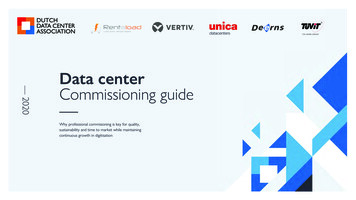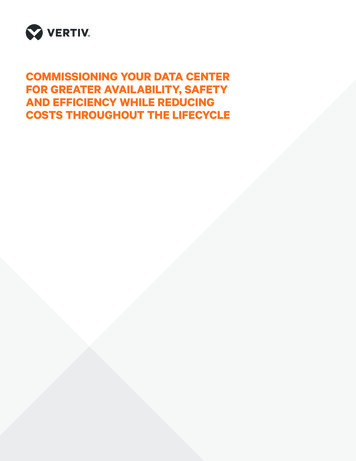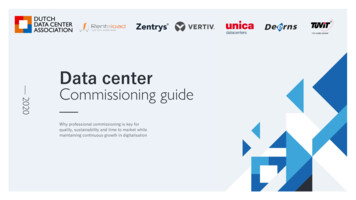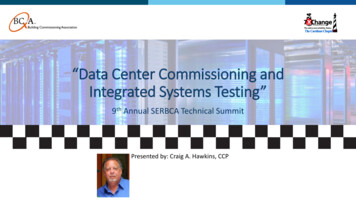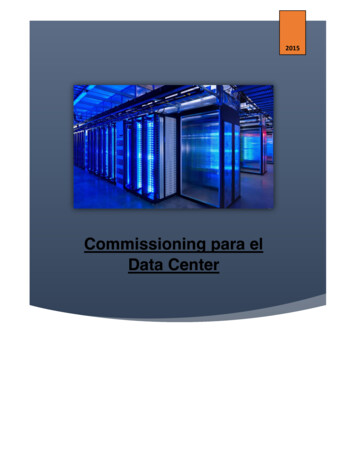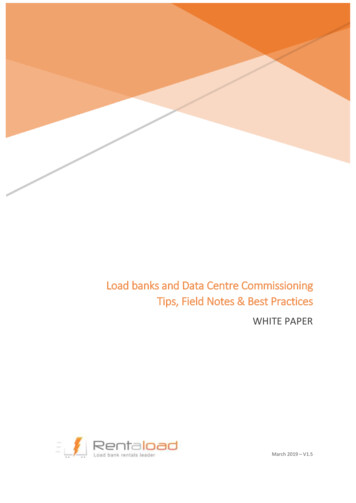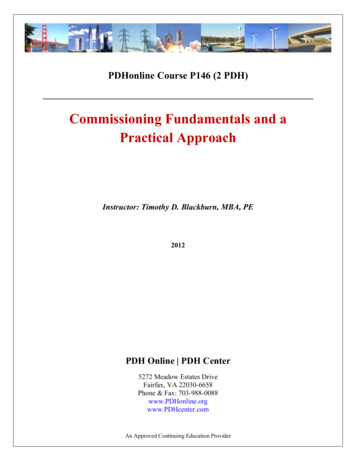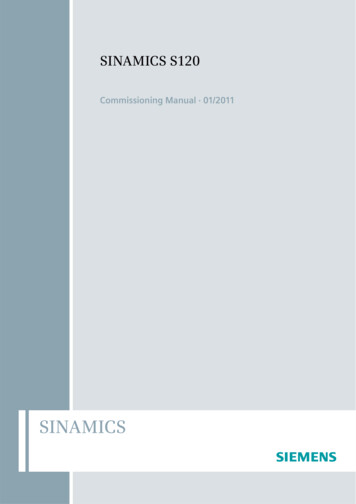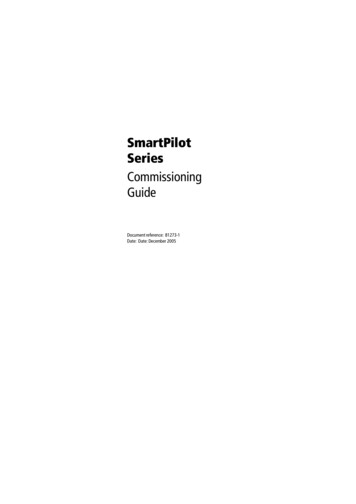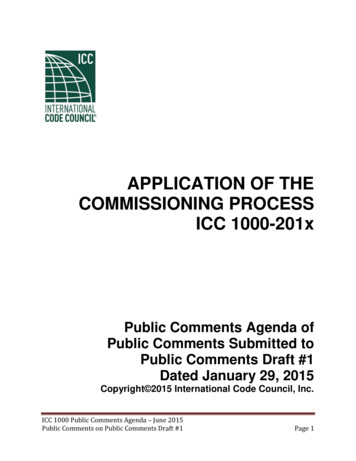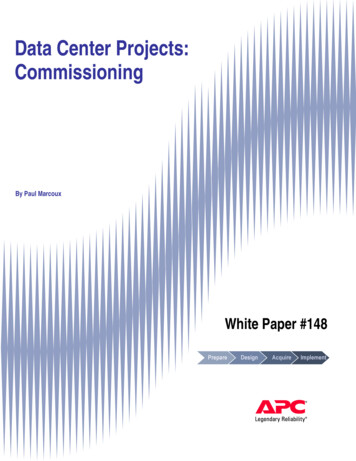
Transcription
Data Center Projects:CommissioningBy Paul MarcouxWhite Paper #148
Executive SummaryFailure to properly commission a data center leaves the door wide open for expensive anddisruptive downtime that could have been avoided. Integrated commissioning of allphysical infrastructure components assures maximum data center performance andjustifies the physical infrastructure investment. This paper reviews the desired outputs andidentifies the standard inputs of the commissioning data center project step. Thecommissioning process flow is described and critical success factors are discussed. Thecommissioning process inputs and outputs are also placed in context with other key datacenter project process phases and steps. 2007 American Power Conversion. All rights reserved. No part of this publication may be used, reproduced, photocopied, transmitted, orstored in any retrieval system of any nature, without the written permission of the copyright owner. www.apc.comWP148 Rev 2007-02
IntroductionWhen building a new data center, the owner of the data center has no guarantee that the various physicalinfrastructure subsystems – power, cooling, fire suppression, security, and management – will worktogether. Commissioning is the process that reviews and tests the data center’s physical infrastructuredesign as a holistic system in order to assure the highest level of reliability.Traditional commissioning is a daunting task. Since formal system operation doesn’t begin until the systemis commissioned, the commissioning team experiences intense pressure to complete the commissioningprocess quickly. Commissioning can involve high expense and requires staffs from different departmentaldisciplines to work together. For these reasons data center commissioning has almost uniquely been22associated with large data centers (over 20,000 ft or 1,858 m ). In the recent past, many data centermanagers chose to roll the dice and perform little or no commissioning, relying only on start-up data to pressahead with launching the new data center. Given the reality of 24x7 operations, however, the alternative ofexposure to major system failures and accompanying downtime is no longer an economically viable option.Commissioning has now become a business necessity.Figure 1 – Data Center Design / Build Project ProcessData center project epPlaced in the context of an entire data center design / build project, the commissioning step is part of theimplementation phase (see Figure 1). Within the implementation phase, commissioning comes after thephysical infrastructure systems have been delivered, assembled, installed, and individually started up. Oncecommissioning is complete, formal orientation and training of data center staff can begin. For a completeoverview of the data center design / build project process, see APC White Paper #140 “Data CenterProjects: Standardized Process”. 2007 American Power Conversion. All rights reserved. No part of this publication may be used, reproduced, photocopied, transmitted, orstored in any retrieval system of any nature, without the written permission of the copyright owner. www.apc.comWP148 Rev 2007-03
Definition of CommissioningCommissioning is defined as a reliability science that documents and validates the result of a data center’sdesign / build process. The roots of commissioning can be traced to the many independent equipmentvendors who, over the last 10 years, provided “start-up” services after having installed their particular datacenter system component. Each start-up process was driven principally by contractual requirements thatoperated in a vacuum, independent of other components. The general contractor hired various equipmentvendors to supply and install their products. These vendors were guided by a construction installationschedule. When each vendor completed their particular product installation, they requested a certificate ofcompletion from the construction manager. The certificate served as proof that the contracted systems wereinstalled and made operational, and only then was the vendor’s request for payment authorized. However,no contractual requirement existed for the disparate products to perform in a fully integrated manner.The practice of commissioning an entire data center developed when standard equipment start-upprocedures consistently failed to identify system-wide weaknesses (see Figure 2). A data center managerwho avoids the time and expense of commissioning has no ability to effectively judge the data center’sability to handle the intended critical loads.Figure 2 – Product focused start-up ignores the proper integration of key subsystemsIntegrated CommissioningSecurityManagementCoolingPhysical Building& GroundsFire SuppressionPowerUPSGenerator By- PassCircuitOtherBreakers SystemsComponent Start-upDetailed commissioning is most often performed for medium and large “green field” (new) data centers.Smaller data centers with mission critical applications can also improve overall data center performancefrom proper commissioning, although cost may be a factor. 2007 American Power Conversion. All rights reserved. No part of this publication may be used, reproduced, photocopied, transmitted, orstored in any retrieval system of any nature, without the written permission of the copyright owner. www.apc.comWP148 Rev 2007-04
A supplemental resource for companies considering data center commissioning is ASHRAE Guideline 0 –the Commissioning Process. This document provides an overview of commissioning, description of eachcommissioning phase, requirements for acceptance of each phase, requirements for documentation of eachphase, and requirements for training of operation and maintenance personnel. For best practicesinformation, consult APC White Paper #149 “Ten Errors to Avoid When Commissioning a Data Center”.Outputs of CommissioningThe knowledge gained from the commissioning exercise should be documented. The following threedocuments need to be produced if the commissioning process is to yield some tangible benefits:1.“As built” script report2.Component error log report3.Trending report“As built” script reportThe “as built” script report highlights the specific system components tested, describes what kinds of testswere performed, and provides a line by line account of how each component either passed or failed the test.The “as built” script serves as an important reference document when, in the future, failure analysis isperformed. The example below outlines the “as built” script report content:Figure 3 –Sample “As built” script report outline1. Data center descriptionA. size in sq ft / sq metersB. key physical infrastructure componentsC. component redundancy levelsD. overall data center criticality level2. Data center design criteriaA. Physical floor plan demonstrating physical infrastructure equipment locations (includes racks)B. Floor plan denoting power distributionC. Floor plan denoting coolant, chiller and fire suppression pipingD. Floor plan with existing air flow patterns3. Component verificationA. model specified (manufacturer, model name, model number, asset ID number)B. model delivered (manufacturer, model name, model number, asset ID number)C. model installed (manufacturer, model name, model number, asset ID number)D. model capacity (kW, volts, amps)E. general equipment condition4. Performance dataA. test proceduresB. expected responseC. actual responseD. designation as pass or fail 2007 American Power Conversion. All rights reserved. No part of this publication may be used, reproduced, photocopied, transmitted, orstored in any retrieval system of any nature, without the written permission of the copyright owner. www.apc.comWP148 Rev 2007-05
Component error log reportThe component error log, also known as Failure Mode Effects Analysis (FMEA), focuses on the specificsystem components that failed the tests and documents how the failed test impacted other componentseither upstream to or downstream of the component in question. This report details the performance dataresults, highlighting errors that have occurred and recommending solutions. Below is an example of thecategories of information presented in a component error log report.Table 1 – Example of component error log reportTest Area /Procedure No./and Sequence IDTest area: PowerProcedure: 21Sequence: 12Failure/Reasonfor FailureImpactedSystemsFailure: UPS failed tosupport load after switchingfrom by-pass mode to fullfunction.Generator, Load Banksand battery banksHave chief electrician verifythat all battery leads areproperly connected and reruntest.Chiller, CRAC,CondenserHave facilities engineer replacepump with spare unit until newunit can be installed.Air distribution system,Sensor aggregationpoint, Smoke detectionunit.Contact vendor to replacesmoke detection unitCorrective ActionReason: Battery leads atthe head of battery stringwere disconnectedTest area: CoolingProcedure: 38Sequence: 3Test area: Fire SystemProcedure: 42389Sequence: 8Failure: Chilled waterfailed to circulate toCRACSReason: Pump locatedbetween condenser andCRAC failed to startFailure: Smoke detectorA6 failed to raise alarmwhen testedReason: Faulty sensornear intakeCommissioning is an ongoing process. Once all operational parameters have been verified and all settingshave been checked, the commissioning documentation serves as a benchmark for monitoring changes andtrends in the data center.Executive summary / Trending reportOnce actual commissioning is completed, a trending report is issued. This report includes a managementsummary of identifiable system performance trends. The summary also contains a high-level systemdescription, highlights issues that were encountered and resolved, and identifies issues that remain open forfuture action. The summary also includes an action plan and a validation statement from the commissioningagent verifying that the data center has fulfilled the company’s design expectations. This report synthesizes 2007 American Power Conversion. All rights reserved. No part of this publication may be used, reproduced, photocopied, transmitted, orstored in any retrieval system of any nature, without the written permission of the copyright owner. www.apc.comWP148 Rev 2007-06
the data gathered from both the “as built” script report and the component error log report. Below is anexample that outlines the content of a commissioning trending report:Figure 4 – Example of trending report outlineExecutive summary1. Data center overview2. Summary of pre-commissioning data (i.e. component start up data)3. Summary of commissioning scopeCommissioning methodology overview1. Procedures tested2. Sequence of testingData center commissioning system performance trends1. Includes data center physical infrastructure power input and heat output2. Projected energy consumption report with both energy-use index (EUI) and energy-costindex (ECI). The EUI is kW per air conditioned sq foot of the data center. The ECI is dollars perconditioned square foot per year.3. Analysis of error logs, with emphasis on root causes.Conclusion1. Possible impacts of future expansionThe commissioning documents should be placed into the data center’s library of procedures and practices(Figure 5). It is important that the acquired knowledge be documented in a formal company system andNOT merely in the possession of one or two individuals who might leave the company.If the commissioning knowledge base is automated, then it can serve as a valuable training tool for vendorsand new staff members who are installing new pieces of equipment. IT help desk and on-site facilitiesdepartments can also use the commissioning data for training. More advanced training can include arequirement that staff be knowledgeable in commissioning test results. In fact, the ability to runcommissioning tests could be used as criteria for attaining internal technological performance certificationlevels.Figure 5 – Commissioning outputs should be fully leveragedCommissioningStep“As Error Log 2007 American Power Conversion. All rights reserved. No part of this publication may be used, reproduced, photocopied, transmitted, orstored in any retrieval system of any nature, without the written permission of the copyright owner. www.apc.comWP148 Rev 2007-07
Typical utilization of commissioning data includes the following: Comparison of future performance against known day-one performance (trending) Training of site staff (i.e. video tape recordings of critical procedures that will need to beperformed in the future) Clarification of root causes of future failures (forensic analysis) Verification of warranty claims, performance assurance claims, and for other insurancepurposes Support data for risk assessment analysis Benchmark data to evaluate overall system performance Identification of system components that need to be either redesigned or retuned Prediction of expected results from system eventsThe commissioning knowledge base should also be used by senior management to estimate the futureusability and life expectancy of the data center.Inputs to CommissioningCommissioning is initiated as a result of several related processes that are executed in advance. These keyinputs include the following:1.Data center site preparation and installation work2.Component start up data3.Data center design parametersData center site preparation and installation workSite coordination assures that installation prerequisites have been identified, verifies that all systemrequirements have been met, reviews electrical and cooling installation requirements with appropriatesubcontractors, and verifies the floor layout design. This is followed by actual installation of the physicalinfrastructure equipment components.Component start up dataBoth data center staff and equipment vendors are responsible for the task of starting up individual systemcomponents. Once a piece of equipment, like a UPS for example, is delivered and installed, the next logicalstep is to perform the start up. Start up generally consists of powering up the system to make sure that thenew equipment component is working properly. The results of these various start up tests need to be madeavailable to the commissioning team prior to the initiation of the commissioning process. The team mustthen decide how much commissioning will be required to provide a sufficient integrated test (see Table 2). 2007 American Power Conversion. All rights reserved. No part of this publication may be used, reproduced, photocopied, transmitted, orstored in any retrieval system of any nature, without the written permission of the copyright owner. www.apc.comWP148 Rev 2007-08
Table 2 – Sample Commissioning Scope ChecklistPower TestsCooling TestsSystem GroundingGeneratorUPSATSIntegrated powersystemChillersChilled water pumpsCooling towerCondenser waterpumpsPipingHeat exchangerCRACDucting / air flowIntegrated coolingsystemEPOFire Suppressionand Security TestsPipesSprinkler systemGaugesPumpsAutomatic alarmsSmoke detectionElectronicsInfrastructureMonitoring Systemsand Controls TestsPower monitoring systemCRAC monitoring systemHumidity sensorsMotion detection sensorsTemperature sensorsBuilding Management SystemMan trapDoor lock systemSecurity cameraData center design parametersIn a traditional data center design, the data center designer takes the operational assumptions (i.e. 5,000foot, Tier II with 10% annual growth) , and then custom designs the data center physical infrastructure usingcustom components. The designer consults colleagues to verify accuracy and to make redesign corrections,and then issues final designs. The design process includes estimations, custom parts, and redesigns – all ofwhich invite multiple errors by increasing complexity. This traditional approach, with all the high risk and highcosts it introduces, discourages many data center managers from investing additional dollars to properlycommission the data center.Modern data center design takes a different approach. A detailed analysis involving power density, criticalitylevels (comparable in part to data center “tier” levels), power and cooling capacity planning, and data centergrowth plans sets the stage for establishing the design. These design parameters are ultimately expressedin the format of a floor plan. The floor plan allows for the commissioning team to formulate a strategy forscripting and testing the integrated system components (see Figure 10).Fortunately, recent innovations in physical infrastructure technology – such as scalable, modular power andcooling components – have helped to introduce standardized components into the design process.Standardization of both products and processes creates wide-ranging benefits in physical infrastructure thatstreamline and simplify every process from initial planning to daily operations. For more information on theavailability, agility, and TCO benefits of physical infrastructure standardization, see APC White Paper #116,“Standardization and Modularity in Network-Critical Physical Infrastructure.” With standard systemcomponents in place, commissioning becomes a less daunting, more affordable, and higher-value task thatcan be employed in both small and large data centers. 2007 American Power Conversion. All rights reserved. No part of this publication may be used, reproduced, photocopied, transmitted, orstored in any retrieval system of any nature, without the written permission of the copyright owner. www.apc.comWP148 Rev 2007-09
Figure 6 – Both internal and external resources provide inputs to commissioningProject Process InputsStart tionHow Commissioning WorksCommissioning helps to compare actual system performance to the performance assumed by designers asthey architected the data center. The essence of commissioning is “reliability insurance.” The main purposeof traditional insurance is to lower the liability should an incident occur in a home or business.Commissioning lowers the risk of failures in the data center by making sure, ahead of time, that the systemworks as an integrated whole. It also can demonstrate how the equipment and systems perform duringfailure scenarios.To determine the value of commissioning, data center managers need to take into account whether the costof downtime is greater than the cost of the commissioning process. According to Einhorn Yaffee Prescott(EYP), a global consulting engineering firm, a good rule of thumb is to invest 2% of the overall data centerproject cost on commissioning. In most cases, data center owners will see a 5-10% ROI benefit in terms ofoverall data center performance as a result of commissioning.1Commissioning ProcessKey commissioning processes include the following:1.Planning2.Investment3.Selection of a commissioning agent4.Scripting5.Setting up of a command center1Einhorn Yafee Prescott, Data Center World, Everything You Need to Know About Commissioning,March 2006 2007 American Power Conversion. All rights reserved. No part of this publication may be used, reproduced, photocopied, transmitted, orstored in any retrieval system of any nature, without the written permission of the copyright owner. www.apc.comWP148 Rev 2007-010
6.Testing7.DocumentingPlanningThe commissioning process begins months ahead of the actual delivery of the physical infrastructureequipment. Regular commissioning meetings should be held several weeks ahead of the actualcommissioning date. Vendors of the various component subsystems should provide start-up documentationas part of the planning process. At these planning meetings, primary and secondary stakeholders are keptinformed of how the commissioning schedule will be organized. Plans can be formulated at these meetingsto set up event sequencing and to coordinate schedules. The responsibilities of the team members who areengage
Commissioning is the process that reviews and tests the data center’s physical infrastructure design as a holistic syst
